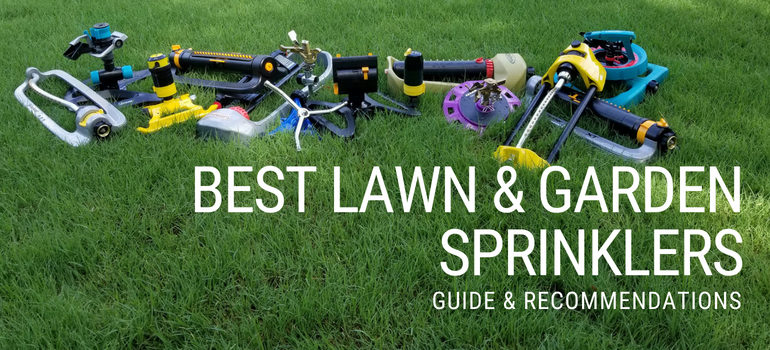Best Lawn & Garden Sprinklers: Guide & Recommendations
We independently evaluate all recommended products and services. If you click on links we provide, we may receive compensation.
Choosing the best sprinklers for your property can make the difference between green grass and beautiful blooming gardens versus a brown lawn and dying plants. Combine the best sprinkler(s) with some simple steps for proper watering, and you’ll end up with a vibrant healthy yard and garden.
With such a wide variety of sprinkler types and models, it’s important to know which one is ideal for your property. Depending on your lawn type and layout and the results you’re looking for, you may need to use more than one type of sprinkler to get the coverage your lawn and garden needs.
In this article, you’ll find:
- Things to consider when buying a lawn and garden sprinkler
- Types of sprinklers, with pros and cons for each
- Our top recommendations for each type of sprinkler (or just click the links below to jump straight to our recommendations)
- Smart watering guidelines for sprinkler use
Important Considerations When Choosing a Sprinkler
Growing up in the Midwest, there was only one metric by which I measured lawn sprinklers: how fun is the water spray to jump through? It turns out that lawn sprinklers are actually to water lawns, though, so you might want to look at other characteristics besides the “fun factor” (although I wouldn’t discount it completely; nothing beats a cold splash of water on a hot summer day!).
Below are some important things to consider when picking out the perfect sprinkler for your landscape.
Your Yard
This is the starting point for choosing a sprinkler.
- How large is the area that needs to be watered? Ideally, you’d choose a sprinkler that can water the entire area, or can cover it with only a few moves.
- What shape is the area (or areas)? There are different sprinklers for square/rectangular, round and pie-shaped areas.
- Are there any nearby structures or areas that shouldn’t get wet? If so, you’ll want a sprinkler that’s highly adjustable so you can easily direct water to only the areas you want.
- How often do you water your lawn and/or plants? The more often you water, the more important convenience features and ease of use become.
- How much water is needed for the areas you’ll be irrigating? Be sure the sprinkler you choose puts out enough water to thoroughly irrigate the area.
- What is the water pressure at the outdoor spigot(s) you’ll be connecting to? Not all sprinklers work well at lower water pressures.
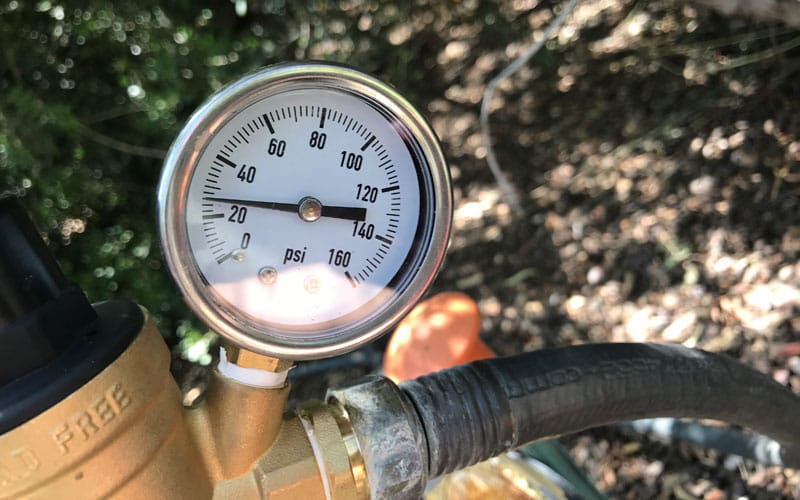
Water pressure can affect how well a sprinkler works - and even whether it works at all. If you have low pressure, choose a sprinkler specifically designed and/or tested to work at low pressure.
Materials
What is the sprinkler made of? If it’s metal it will be more likely to last, but it will be heavier and thus harder to move (although, realistically, no sprinkler is going to be too heavy to move easily).
Note especially the connection points to the hose and the moving parts – ideally, these should be metal.
Also look at the nozzles; on an oscillating sprinkler, these should either be metal (with an included nozzle needle to unclog them when needed) or a flexible material (which you can unclog simply by rubbing them with your hand).
Convenience
Where is the flow control? Is there an on/off switch? Will you get soaked trying to reach it?
Coverage Shape and Area
How large an area does the sprinkler water? Will you have to move it many times to ensure your entire yard is watered? What is the shape of the area it covers? Can you daisy chain (link) several sprinklers together to enlarge the coverage area?
Coverage Consistency
Does the sprinkler emit the same amount of water across the entire area, or will some spots get more water than others?
Adjustability
Some basic oscillating sprinklers are pretty simple – turn the water on and it moves back and forth in a set pattern without any adjustments. Others are more complex, with knobs, dials and/or levers to control the width, length, and flow of water. Check how easy and intuitive the controls are to use (for example, impact sprinklers are notoriously difficult to adjust without some practice first), and whether or not they actually make a noticeable difference. Depending on your yard, you may not need a high level of adjustability.
Stability
A sprinkler should sit flat on the ground (if it has a sled base) or be perfectly vertical (if it’s on a stake). Plus, it should stay put while in operation. Generally, sprinklers with a wider and/or heavier base will be more stable.
Hose End Coupling
Make sure the connector between the sprinkler and hose is easy to grasp and not slippery. Larger couplings with knobs or a non-slip surface are generally easier to use. There should be a washer inside the connector, as well as a sieve or strainer to keep out debris that could clog the nozzles.
The threads on metal couplings are less likely to strip (so leaks are less likely) and will last longer, although most sprinklers have plastic couplings.
And look for a connector that swivels when connected to the hose; this will help the sprinkler lay flat without having to “fight” with the hose.
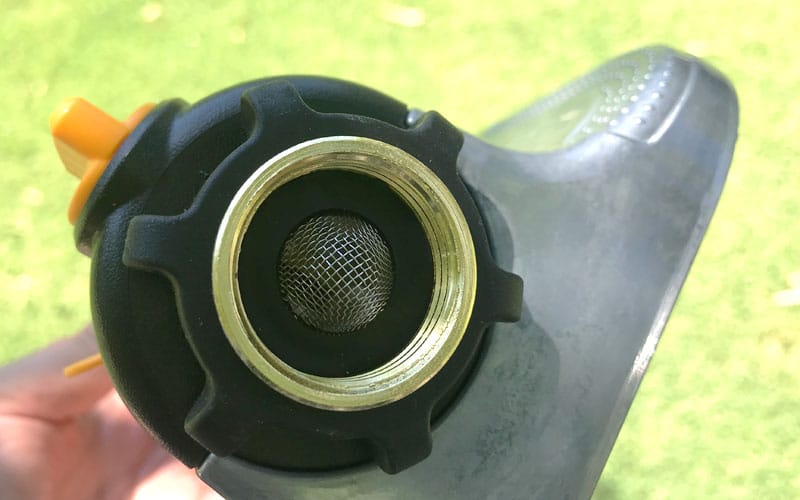
This oscillating sprinkler has a large grip with knobs, a metal connector, washer, and strainer.
Types of Lawn Sprinklers
The most common type of sprinkler for homeowners is a hose-end sprinkler, although there are a wide variety of styles. Plus, as technology improves, more types of sprinklers become available.
Here are some of the most popular types and categories, along with some of the pros and cons of each.
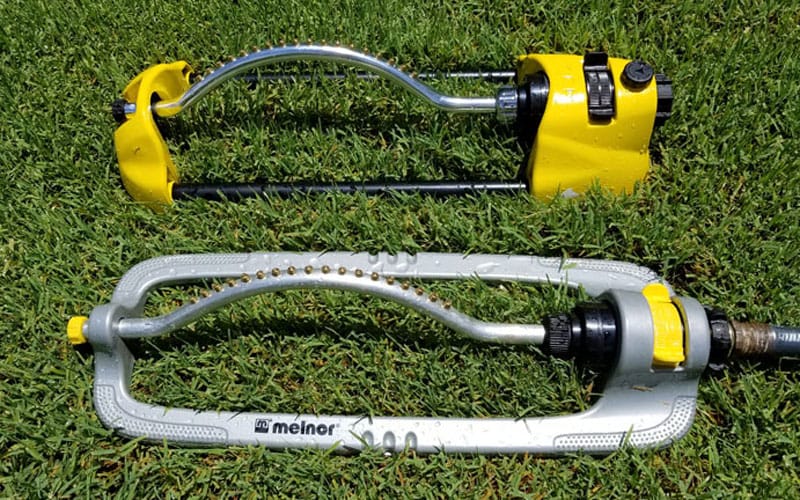
Basic, tubular oscillating sprinklers
Oscillating Sprinklers
(My preferred option for jumping through, in case you really wanted to know). Oscillating sprinklers provide a wide, waterfall-like watering pattern in a rectangular shape and are probably the most common type of sprinkler seen on North American lawns.
They usually consist of a long tube or barrel with numerous nozzles along its length. Water shoots out in thin streams from the nozzles, and the tube or barrel rotates to make the water jets move from side to side.
Look for an oscillating sprinkler that has easy-to-use controls for width and length so you can adjust the size of the area being irrigated. Not all are intuitive to use (for example, it’s often not clear which way to move the controls to widen or narrow the spray pattern, so you end up getting soaked trying to make adjustments while the sprinkler is on). Larger knobs or levers that can be easily grasped, and highly visible markings that indicate which way to move them, are very helpful.
Also look at the nozzles; on an oscillating sprinkler, these should either be metal (with an included nozzle needle to unclog them when needed) or a flexible, rubber-like material (which you can unclog simply by rubbing them with your hand). The nozzle needle is usually screwed into the end of the sprinkler opposite the hose. Be careful not to lose it or the sprinkler won’t work.
If you’re buying a sprinkler to entertain children, this is the type to get. You can jump through it when it’s high, run away from the jets as they get lower and lower, put your finger over some of the jets to make the others shoot higher—you get the idea.
Uses: All sizes of rectangular areas, like lawns or gardens
Pros:
- Square/rectangular pattern allows you to get water into corners
- Generally has fairly consistent coverage over most of the irrigated area (depending on wind), although it can taper off toward the edges of the spray pattern
- Can adjust the coverage area (to some extent) by adjusting water flow at the spigot
- Larger water drops similar to a heavy rain
Cons:
- Sprays high in the air so is more likely to be impacted by wind
- Water can be lost due to evaporation (this is made worse in windy or hot, dry conditions)
- Some emit significantly more water close to the sprinkler than farther away, soaking the area nearb
Oscillating Sprinkler Reviews
| Oscillating Sprinklers | Description | Our Rating | |
|---|---|---|---|
 | Dramm ColorStorm Premium Metal Oscillating Sprinkler W/Brass Nozzle Jets It's simple, easy to use, made of quality construction, and comes in six fun colors. The rubberized connector makes it easy to connect to a garden hose. HIGHEST RATED BASIC OSCILLATING SPRINKLER READ OUR REVIEW | 5.0 | |
 | Melnor XT Mini-Turbo Oscillating Sprinkler with One Touch Width Control & Flow Control We loved the adjustment options, including width, length and the 360-degree rotating head. HIGHEST RATED ADJUSTABLE OSCILLATING SPRINKLER READ OUR REVIEW | 4.8 | |
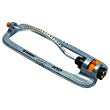 | Melnor XT Metal Turbo Oscillating Sprinkler A basic oscillating sprinkler that's sturdy and works well for square or rectangular yards. READ OUR REVIEW | 4.6 | |
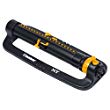 | Melnor XT Turbo Oscillating Sprinkler with TwinTouch Width Control & Flow Control Adjustment controls for flow, length and width, and an easy-to-use hose connector. READ OUR REVIEW | 4.3 | |
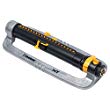 | Melnor XT Metal Turbo Oscillating Sprinkler with TwinTouch Width Control & Flow Control Same as above but with a metal base for added weight and stability. READ OUR REVIEW | 4.3 | |
| Gilmour Heavy Duty Rectangular Sprinkler (with on/Off Switch) A handy on-off switch and plenty of adjustment options. READ OUR REVIEW | 4.0 |
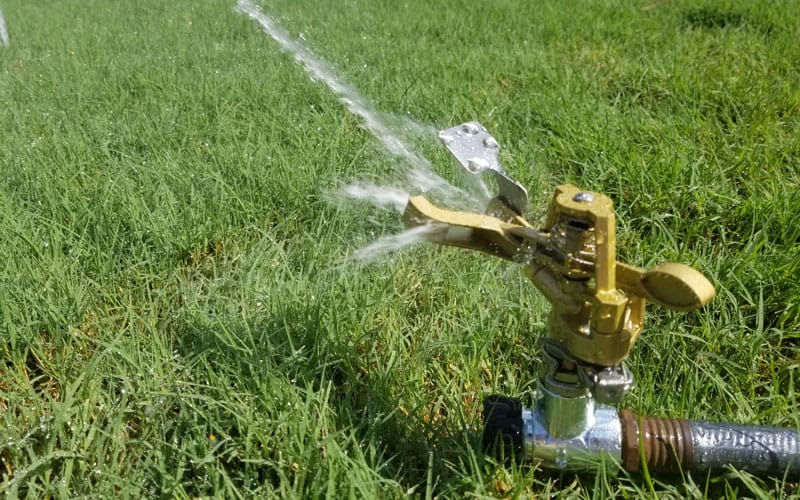
Melnor Pulsating (impact) Sprinkler with step spike
Impact Sprinklers
Impact sprinklers use a powerful stream of water pressure to move the sprinkler arms in a circular pattern (or part of a circle), making a distinctive clicking sound as they do. Because the spray from an impact sprinkler typically comes out with considerable force, it’s fairly wind-resistant (the spray doesn’t get blown around as much as with other types of sprinklers) and water covers a large distance.
With most impact sprinklers, you can adjust how forcefully the water sprays out (by adjusting or removing the diffuser pin), how high and far it sprays (by adjusting the deflector shield), and how much of a circular pattern it covers (usually from 15 to 360 degrees). However, adjusting it can be tricky, so either practice before taking it into the garden, or look for some of the newer models that make adjustment easier.
This type of sprinkler works well on large lawns and the low angle of the water stream makes it efficient for watering yard areas with low hanging trees. Avoid using impact sprinklers on delicate landscape plants and flowerbeds unless you’ve got the diffuser pin inserted to break up the water flow.
Uses: Large areas like front and back lawns
Pros:
- Spray is generally lower to the ground and doesn’t get blown around
- Pie shaped to circular coverage area
- Can cover larger areas than most other styles
- Less likely to clog than styles with individual emitters
Cons:
- Round coverage area may not work if your lawn or garden is square/rectangular
- Most models have inconsistent coverage, with the amount of water varying based on distance from the sprinkler
- Generally do not work well with low water pressure
| Impact Sprinklers | Description | Our Rating | |
|---|---|---|---|
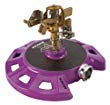 | Dramm 15087 Circular Base Impulse Sprinkler with a Heavy-Duty Metal Base Available in six colors and a variety of base options (spike, wheeled or circular). READ OUR REVIEW | 4.5 | |
| Melnor 9536H All Metal Pulsating Sprinkler with Step Spike READ OUR REVIEW | 4.3 | ||
 | Gilmour Pattern Master Impulse Sprinkler | 2.5 | |
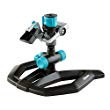 | Gilmour Medium Duty Hybrid Impact Sprinkler with Base READ OUR REVIEW | 2.3 |
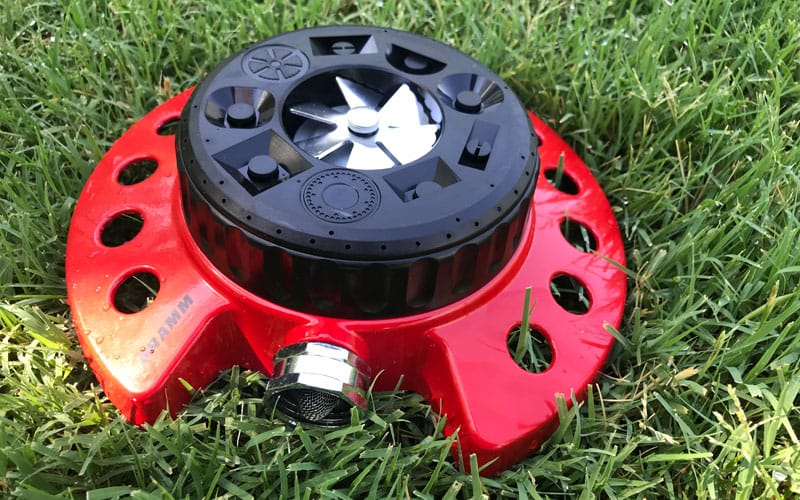
9-pattern stationary sprinkler from Dramm
Fixed (Stationary, Spike) Sprinklers
These simple, inexpensive, and easy-to-use sprinklers come in various sizes, shapes, and designs so you can choose which spray pattern works best for your lawn. Some spray in a single pattern over a fixed area (such as a fountain-like pattern or a square shape), while others offer multiple spray patterns (usually by rotating a pattern selector on the top of the sprinkler).
Stationary sprinklers don’t distribute water far enough to effectively water large yards, but typically do a great job of watering smaller areas. And many of them work well with low water pressure.
Some can distribute large volumes of water, which allows you to finish watering rather quickly but check for excessive runoff. To ensure even coverage with a stationary sprinkler, you’ll have to keep an eye on it and move it fairly often.
Uses: Small areas like gardens and landscaping
Pros
- Good for small areas
- Many work well with low water pressure
- Some have multiple spray patterns to cover different yard/garden shapes
Cons
- Requires more monitoring to avoid overwatering
| Stationary Sprinklers | Description | Our Rating | |
|---|---|---|---|
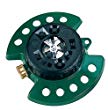 | Dramm ColorStorm Turret 9-Pattern Sprinkler With 9 patterns to choose from, it can cover nearly any shaped lawn or garden. Available in fun six colors. READ OUR REVIEW | 4.8 | |
 | Dramm ColorStorm 4-Pattern Gear Drive Sprinkler An excellent option for a mid-sized yard. Four different patterns to choose from and the ability to easily customize the spray arc. READ OUR REVIEW | 4.8 | |
| Dramm ColorStorm Spinning Sprinkler A wonderful sprinkler for low water pressure situations. Available in fun six colors. READ OUR REVIEW | 4.6 | ||
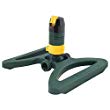 | Melnor Turbo Rotary Sprinkler Available with either a sled or a spike base. | 3.8 |
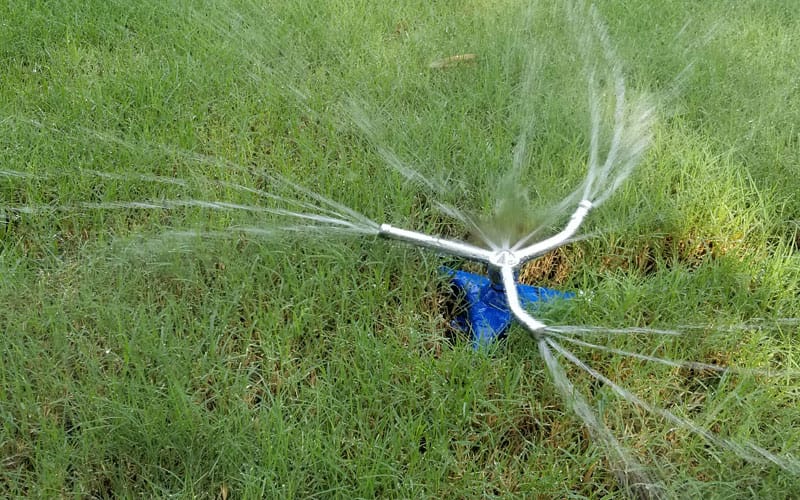
Dramm ColorStorm Whirling Sprinkler
Rotating (Rotary) Sprinklers
Rotating (or rotary) sprinklers feature two or more arms that spin to disperse water in a complete circle. Sprinkler heads are built into the end of each arm and water pressure turns the gears to rotate the arms and spray the water in a full circle.
This type of sprinkler covers an area fairly evenly, making it an economical choice for larger gardens and open areas of lawn that can accommodate its circular spray pattern. The gentle but steady watering pattern makes it ideal for watering flowerbeds and shrubs as well.
There are generally no adjustment options with a rotary sprinkler but you can change the coverage area by changing the water flow at the spigot.
Uses: Large areas like front and back lawns or large gardens
Pros:
- Gives even coverage
- Water droplets are smaller than oscillating sprinklers so not prone to harm tender plants
Cons:
- Circular pattern is not appropriate for square/rectangular yards
| Rotary Sprinklers | Description | Our Rating | |
|---|---|---|---|
 | Dramm ColorStorm Premium 3-Arm Whirling Sprinkler with Heavy-Duty Metal Wheeled Base Available in fun six colors. READ OUR REVIEW | 4.4 |
Traveling Sprinklers
You’ll recognize these by the tiny tractor that moves on wheels, with the hose guiding it as the “track”.
The traveling sprinkler moves along the hose path on its own, evenly covering large flat areas in a quiet consistent path and avoiding overwatering. You’ll need sufficient water pressure to keep it moving and it’s best to keep an eye on it to avoid the sprinkler stalling and flooding areas of the lawn.
Uses: For large flat areas like front and backyards
Pros:
- Can cover larger areas depending on the length of hose attached
- Low risk of overwatering as there is constant movement, allowing water to be absorbed fully
Cons:
- Can become stuck in place if the area has inclines or higher grass length
- Requires more monitoring
- Not recommended for newly seeded areas
- Does not work with low water pressure
Sprinkler Hoses
No big surprise here, sprinkler hoses are just what they sound like – garden hoses with tiny holes that squirt water along the length of the hose to irrigate a rectangular area.
They are ideal for watering narrow lawn areas with curved and irregular shapes, or for placing in a circle around newly planted trees
Uses: Localized watering like small border gardens and other landscaping areas, and narrow spaces
Pros:
- Allows you to water narrow areas or irregular shapes that can’t be adequately covered with other sprinklers
Cons
- Short lifespan - sprinkler hoses tend to deteriorate quickly
- Limited coverage
- Low output (especially if the holes get clogged)
Enjoyed This Review?
If you liked this review, please sign up for our email updates with reviews, how-to articles and gardening videos!

